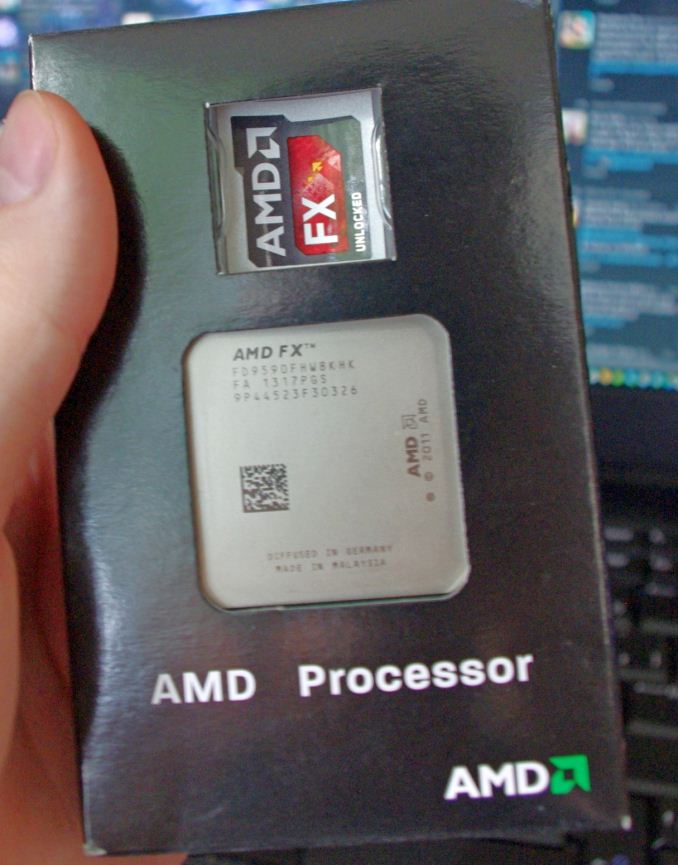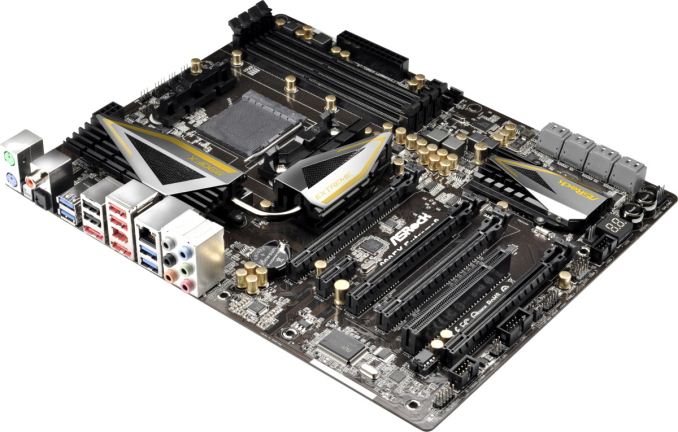AMD’s 5 GHz Turbo CPU in Retail: The FX-9590 and ASRock 990FX Extreme9 Review
by Ian Cutress on August 9, 2014 8:00 AM ESTThe AMD FX-9590
The analysis in this review shows that even a year after the OEM release of the FX-9590, and almost two years from the architecture coming to market it remains AMD’s performance part. If power consumption is not a concern, as a CPU compute and an AMD gaming CPU (especially when considering SLI) the FX-9590 is the best choice at stock speeds. On that basis alone, it makes sense that AMD should actually release it as a retail part, assuming they have enough stock. One might argue that a user could buy an FX-8350 and overclock, but if our sample CPUs were anything to go by, a user needs a fair bit of luck. The FX-9590 guarantees a 5.0 GHz turbo with a warranty.
With the retail release of the CPU, that warranty might be based on using the water cooling provided for the lifetime of the CPU. One might argue that AMD had trouble finding enough dies that could reach the frequencies and voltages for the FX-9590, and hence the delay combined with selling the SKU in select markets only.
The FX-9590 is the same Piledriver architecture as the FX-8350, which in turn was used in the A10-5800K/A10-6800K APUs, codename ‘Trinity’ and ‘Richland’ respectively. Since then, AMD has launched the Steamroller architecture modifications in the form of Kaveri APUs. The difference between a PIledriver APU and a similar frequency Steamroller APU, if we put aside the move from 32nm SOI to 28nm SHP, is around 10% for CPU performance. If that was shifted into a four-module, eight-thread CPU, it would surely be AMD’s performance part. The issue here is that AMD has almost discarded the high CPU performance arena in favor of integrated graphics. From Trinity to Kaveri, the IGP inside those APUs has improved considerably, indicating where AMD is investing its research dollars.
AMD clearly still cares about the performance market, otherwise this retail FX-9590 with water cooling would have never been pushed through to retailers. The high power consumption, the lack of a modern chipset, and the comparison to Intel CPUs in single threaded benchmarks are the main barriers to adoption. If AMD is to return to the performance market, the power consumption has to be comparable to Intel, or if it is slightly higher, the chipset has to offer something Intel cannot. Any suggestions for what that feature should be should be submitted on a postcard/in the comments.
ASRock 990FX Extreme9 Conclusion
One of the big issues surrounding AMD motherboards is their price sensitive nature. With an Intel based product, a $250-$400 motherboard is common enough to signify the expense in research or extra features. Because the AMD ecosystem, even in the high performance segment, is a cost sensitive market there is little room to move. For example, this year sees the first overclocking based motherboard for AMD APUs since the AM3+ era. So at $170, the Extreme9 could arguably be described as ‘limited’ compared to Intel standards.
The motherboard itself has specified support for 220W CPUs, something other motherboards either fail to mention or advise against completely. The native SATA 6 Gbps ports were ahead of Intel at the time, plus ASRock adds in another SATA 6 Gbps controller for good measure.
The eight USB 3.0 ports makes the Extreme9 have more USB 3.0 ports than almost every other 990FX/AM3+ motherboard ever released. This is combined with plenty of legacy support, such as separate PS/2 connectors, a PCI slot, an IEEE1394 port and an IEEE1394 header. The Intel NIC is paired with a Realtek ALC898 codec, with the PCIe layout aimed at 3-way GPU users for both Crossfire and SLI.
Aside from an updated chipset, if we were building a high-end AM3+ motherboard in 2014, I would insist on WiFi support and an upgraded audio codec to the ALC1150 at the minimum. We cannot get around the lack of PCIe 3.0 support, although moving the CPU modules from Piledriver to Steamroller along with the IO support might help with that. If we are being greedy with what we would like, I would add in M.2 support as well.
There is plenty to speculate if AMD had kept updating their high-end performance CPU line, even if the socket was not updated. As it stands, users who want SLI either look back to 990FX or invest in Intel. Users who want high multithreaded CPU performance either look back to 990FX or invest in Intel. Users who do not want processor graphics either look back to 990FX, buy an APU with the graphics disabled, or invest in Intel. AMD clearly does care about the performance market, or at least someone senior in the company does.












146 Comments
View All Comments
dave1231 - Saturday, August 9, 2014 - link
Running this chip at load 24/7 at 18p per kWh for a year would cost about £525 although you might be able to turn your heating down a bit. Should be consigned to history.tech6 - Saturday, August 9, 2014 - link
+1: Such abysmal efficiency makes no sense at all. If this is supposed to be a 2014 product then I fear for the future of AMD.shabby - Saturday, August 9, 2014 - link
Efficiency goes out the door once you start overclocking.Flunk - Saturday, August 9, 2014 - link
That's not true at all, a lot of Intel CPUs will take a supstantial overclock with no or very slight voltage adjustments and then not exceed TDP by more than 25%. Overclocking THIS processor throws efficiency out the door but there are gains to be made at reasonable costs with Intel's Core processors.shabby - Saturday, August 9, 2014 - link
An extra 1ghz on an i7-4770k increases wattage by 60%http://www.pcper.com/files/imagecache/article_max_...
Which article is showing a 25% increase?
SmokingCrop - Saturday, August 9, 2014 - link
This one does: http://www.bit-tech.net/hardware/2013/06/01/intel-...Intel Core i7-4770K
3.5GHz -> 137 Watt
4.7GHz -> 171 Watt
shabby - Saturday, August 9, 2014 - link
One article shows a 25% increase with a 1.2ghz oc while another shows 60% increase with a 1ghz oc ... so which ones right?tuxRoller - Sunday, August 10, 2014 - link
Possibly both. Depends on where these tests are done (the line voltage), components used, and, most importantly, the binning.basroil - Sunday, August 10, 2014 - link
Both can be correct, depends on the test. Chips aren't as easy as pipeline clock increases, memory limited applications are still fairly common, as are cache limited ones (L1 cache should increase in speed but L2 and L3 won't in most cases), and there are still others that are unstable and can see huge jumps depending on how in sync components are.That said, seeing a performance increase larger than the clock increase (all in %) is rare at best, downright lying in most cases though. Usually a 50% increase will give you a 25-50% increase in non-memory limited applications.
basroil - Sunday, August 10, 2014 - link
Strike the above, misread the comment!But actually very close, just replace everything with mobo, cooling, and lot. Some chips overclock better than others, and some motherboards and cooling help achieve that at lower voltages (and therefore power) than others. Your CPU might need 1.2V to hit 4.5gh while another needs 1.25V just to hit 4, it's just the luck of the draw.